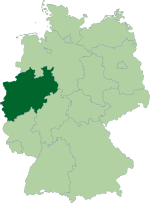Solingen
Solingen (German pronunciation: [ˈzoːlɪŋən] (![]()
Solingen | |
|---|---|
Solingen-Mitte | |
 Flag  Coat of arms | |
Location of Solingen 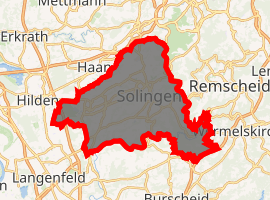
| |
 Solingen 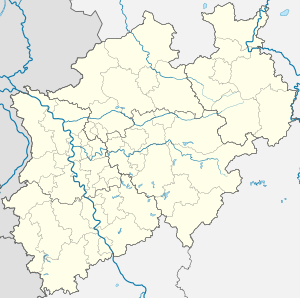 Solingen | |
| Coordinates: 51°10′0″N 07°05′0″E | |
| Country | Germany |
| State | North Rhine-Westphalia |
| Admin. region | Düsseldorf |
| District | Independent city |
| Government | |
| • Lord Mayor | Tim Kurzbach (SPD) |
| Area | |
| • Total | 89.45 km2 (34.54 sq mi) |
| Highest elevation | 276 m (906 ft) |
| Lowest elevation | 53 m (174 ft) |
| Population (2018-12-31)[1] | |
| • Total | 159,360 |
| • Density | 1,800/km2 (4,600/sq mi) |
| Time zone | CET/CEST (UTC+1/+2) |
| Postal codes | 42601-42719 |
| Dialling codes | 0212 |
| Vehicle registration | SG |
| Website | www.solingen.de |
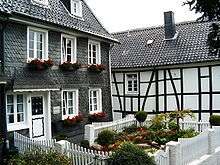
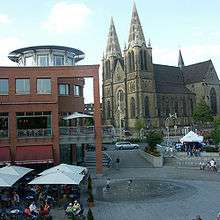
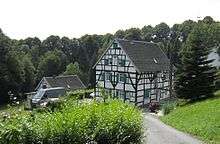
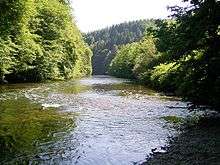
Solingen is called the "City of Blades", since it has long been renowned for the manufacturing of fine swords, knives, scissors and razors made by famous firms such as WKC, DOVO, Wüsthof, Zwilling J. A. Henckels, Böker, Hubertus, Diefenthal, Puma, Clauberg, Eickhorn, Linder, Carl Schmidt Sohn, Dreiturm, Herder, and numerous other manufacturers.
In Medieval times, the swordsmiths of Solingen designed the town's coat of arms, which continues to the present. In the latter part of the 17th century, a group of swordsmiths from Solingen broke their guild oaths by taking their sword-making secrets with them to Shotley Bridge, County Durham in England.
Geography
Solingen lies southwest of Wuppertal in the Bergisches Land. The city has an area of 89.45 square kilometres (34.54 sq mi), of which roughly 50% is used for agriculture, horticulture, or forestry. The city's border is 62 kilometres (39 mi) long, and the city's dimensions are 15.6 kilometres (9.7 mi) east to west and 11.7 kilometres (7.3 mi) north to south. The Wupper river, a right tributary of the Rhine, flows through the city for 26 kilometres (16 mi). The city's highest point at 276 metres (906 ft) is in the northern borough of Gräfrath at the Light Tower, previously the water tower, and the lowest point at 53 metres (174 ft) is in the southwest.
Neighbouring cities and communities
The following cities and communities share a border with Solingen, starting in the northeast and going clockwise around the city:
- Wuppertal (unitary urban district)
- Remscheid (unitary urban district)
- Wermelskirchen (within the Rheinisch-Bergischer district)
- Leichlingen (Rheinisch-Bergischer district)
- Langenfeld (within the district of Mettmann)
- Hilden (Mettmann)
- Haan (Mettmann)
City administration
Solingen currently consists of five boroughs. Each borough has a municipal council of either 13 or 15 representatives (Bezirksvertreter) elected every five years by the borough's population. The municipal councils are responsible for many of the boroughs' important administrative affairs.
The five city boroughs:
- Gräfrath
- Wald (Solingen)
- (Solingen-)Mitte
- Ohligs/Aufderhöhe/Merscheid
- Höhscheid/Burg
The individuals boroughs are in part composed of separate quarters or residential areas with their own names, although they often lack precise borders. These areas are:
- Aufderhöhe: Aufderbech, Börkhaus, Gosse, Horn, Holzhof, Josefstal, Landwehr, Löhdorf, Pohligsfeld, Riefnacken, Rupelrath, Siebels, Steinendorf, Ufer, Wiefeldick
- Burg: Angerscheid, Höhrath
- Gräfrath: Central, Flachsberg, Flockertsholz, Focher Dahl, Fürkeltrath, Heide, Ketzberg, Külf, Nümmen, Piepersberg, Rathland, Schieten, Zum Holz
- Höhscheid: Balkhausen, Bünkenberg, Dorperhof, Friedrichstal, Fürkelt, Glüder, Grünewald, Haasenmühle, Hästen, Katternberg, Kohlsberg, Meiswinkel, Nacken, Pfaffenberg, Pilghausen, Rölscheid, Rüden, Schaberg, Schlicken, Unnersberg, Weeg, Widdert, Wippe
- Merscheid: Büschberg, Dahl, Dingshaus, Fürk, Fürker Irlen, Gönrath, Hübben, Hoffnung, Limminghofen, Scheuren, Schmalzgrube
- Mitte: Entenpfuhl, Eick, Grunenburg, Hasseldelle, Kannenhof, Kohlfurth, Krahenhöhe, Mangenberg, Meigen, Müngsten, Papiermühle, Scheidt, Schlagbaum, Schrodtberg, Stöcken, Stockdum, Theegarten, Vorspel, Windfeln
- Ohligs: Brabant, Broßhaus, Buschfeld, Caspersbroich, Deusberg, Engelsberger Hof, Hackhausen, Keusenhof, Mankhaus, Maubes, Monhofer Feld, Poschheide, Scharrenberg, Schnittert, Suppenheide, Unterland, Wilzhaus, Verlach
- Wald: Bavert, Demmeltrath, Eschbach, Eigen, Fuhr, Garzenhaus, Itter, Kotzert, Lochbachtal, Rolsberg, Vogelsang, Weyer
History
Middle Ages
Solingen was first mentioned in 1067 by a chronicler who called the area "Solonchon". Early variations of the name included "Solengen", "Solungen", and "Soleggen", although the modern name seems to have been in use since the late 14th and early 15th centuries.
Blacksmiths' smelters, dating back over 2000 years, have been found around the town, adding to Solingen's fame as a Northern Europe blacksmith centre. Swords from Solingen have turned up in places such as the Anglo-Saxon kingdoms in the British Isles. Northern Europe prized the quality of Solingen's manufactured weaponry, and they were traded across the European continent. Solingen today remains the knife-centre of Germany.
It was a tiny village for centuries, but became a fortified town in the 15th century.
Thirty Years War
After being ravaged by the plague from 1614-1619, with about 1800 deaths, Solingen was heavily fought-over during the Thirty Years War, repeatedly attacked and plundered, and the Schloss Burg was destroyed.
Modern Age
Interwar Period

In 1929 Ohligs, located in the Prussian Rhine Province, 17 miles (27 km) by rail north of Cologne became part of Solingen. Its chief manufactures were cutlery and hardware, and there were iron-foundries and flour mills. Other industries were brewing, dyeing, weaving and brick-making.
World War II
In World War II the Old Town was completely destroyed by an air raid by the British Royal Air Force in 1944; 1,800 people died and over 1,500 people were badly injured.[3] As such, there are few pre-war sites in the centre.
Skinhead terrorism
In 1993 Solingen, the birthplace of Adolf Eichmann became once again the scene of racist violence with its 1993 Solingen arson attack, when four skinheads, with neo-Nazi ties, set fire to the house of a large Turkish family. Three girls and two women died; fourteen other family members, including several children, were injured, some of them severely.[4]
Population
Solingen's population doubled between the years 1880 and 1890 due to the incorporation of the town of Dorp into Solingen in 1889, at which time the population reached 36,000. The population again received a large boost on August 1, 1929 through the incorporation of Ohligs, Wald, Höhscheid, and Gräfrath into the city limits. This brought the population above the 100,000 mark, which gave Solingen the distinction of being a "large city" (Großstadt). The number of inhabitants peaked in 1971 with 177,899 residents, and the 2006 population figure was 163,263.
The following chart shows the population figures within Solingen's city limits at the respective points in time. The figures are derived from census estimates or numbers provided by statistical offices or city agencies, with the exception of figures preceding 1843, which were gathered using inconsistent recording techniques.
|
|
|
- Census results
30.9% of the population of Solingen has foreign roots (statistics 2012).
| Largest groups of foreign residents | |
| Nationality | Population (31.12.2017) |
|---|---|
| 5,960 | |
| 5,925 | |
| 1,660 | |
| 1,545 | |
| 1,370 | |
Transportation
Rail
Solingen Hauptbahnhof is served by Rhine-Ruhr S-Bahn line S1 from Düsseldorf and Düsseldorf Airport Station. S-Bahn line S7 links Solingen (including the station nearest the town centre, Solingen Mitte, and Solingen-Grünewald) to Wuppertal via Remscheid, Remscheid-Lennep and Wuppertal-Ronsdorf. This line has been operated by Abellio Deutschland since 15 Dec. 2013. The Rhein-Wupper-Bahn (RB 48) runs over the Gruiten–Köln-Deutz line to Bonn-Mehlem via Opladen and Cologne. It has been operated by National Express as of 13 Dec. 2015.
| Railway stations of Solingen | |||
|---|---|---|---|
| Station | Lines served | Destinations | Notes |
| Solingen Hauptbahnhof | Dortmund – Solingen – Mannheim – Munich (InterCity Express) | Interchange with Obus Solingen (trolleybus) lines 681, 682. | |
| Hannover – Solingen – Cologne – Mannheim – Basel (InterCity Express) | |||
| Dortmund – Solingen – Frankfurt – Vienna (InterCity Express) | |||
| Hamburg – Solingen – Cologne – Frankfurt (InterCity) | |||
| Leipzig – Hannover – Solingen – Cologne | |||
| Krefeld – Cologne – Solingen – Wuppertal – Hagen – Hamm – Münster – Rheine (RegionalExpress) | |||
| S-Bahn to Wuppertal Hauptbahnhof via Remscheid | |||
| Wuppertal-Oberbarmen – Solingen – Cologne – Bonn-Mehlem (RegionalBahn) | |||
| S1 | S-Bahn to Dortmund | ||
| S7 | S-Bahn to Wuppertal via Remscheid | ||
| Solingen Mitte | S7 | Nearest station to historic centre. Interchange with trolleybus lines 681, 683, 684, 686. | |
| Solingen Grünewald | S7 | Interchange with trolleybus line 682. | |
| Solingen Vogelpark | S1 | ||
| Solingen Schaberg | S7 | ||
Trolleybus
Solingen has a trolleybus network, one of only three in Germany remaining besides Eberswalde and Esslingen am Neckar.[5]
Air transport
The nearest airports are Düsseldorf Airport and Cologne Bonn Airport. Both airports can be reached by train from Solingen-Hauptbahnhof (change trains at Köln Messe/Deutz station for the S-Bahn 13 to Cologne Bonn Airport). Other easily reached airports are those of Frankfurt am Main (ICE train stop), Dortmund (railway station "Holzwickede" on the RE7 trainline) and the low cost Weeze Airport (coaches from Düsseldorf Hauptbahnhof).
Religion
Christianity
Solingen has belonged from its beginnings to the Roman Catholic Archdiocese of Cologne (Erzbistum Köln), and more specifically to the Archdeaconry of the Probst (provost) of St. Kunibert, the deanery of Deutz. Although the Protestant Reformation gradually made gains in the city, which was under the control of the Counts of Berg, the population by and large remained Roman Catholic for a while. The Catholic community was newly endowed by the local lord in 1658 and in 1701 received a new church building. In 1827 Solingen became the seat of its own deanery within the newly defined Archdiocese of Cologne, to which the city's current parishes still belong.
As mentioned, the Reformation only gradually gained a foothold in Solingen. A reformed church affiliated with the Bergisch synod was established in 1590, and the city's parish church became reformed in 1649. Lutherans had been present in Solingen since the beginning of the 17th century, and a Lutheran congregation was founded in 1635. In 1672 a formalized religious agreement was reached between the city's religious groups. The Reformation was also introduced in Gräfrath in 1590, where a church council was apparently established in 1629. The Reformed and Lutheran churches were formed into a united church community in 1838 following the general merger of Reformed and Lutheran churches in Prussia in 1817.
The Protestant parishes originally belonged to the district synod of Lennep, today part of the city Remscheid. A new synod was established in Solingen in 1843, and the city acquired its own superintendent, a form of church administrator. This formed the basis for the present-day Church District of Solingen, a member of the Evangelical Church in the Rhineland. With the exception of the free churches, most Protestant churches belong to the Church District of Solingen.
Today approximately 34% of Solingen's population belongs to Protestant churches, and roughly 26% belong to Catholic churches. Other church communities in Solingen include Greek Orthodox, Evangelical Free (including Baptist and Brethren), Methodist, Seventh-day Adventist, Pentecostal, Salvation Army, and free churches. The Church of Jesus Christ of Latter-day Saints, Jehovah's Witnesses and the New Apostolic Church also have communities in Solingen.
Image gallery
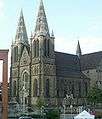 Catholic Church St. Clemens
Catholic Church St. Clemens Protestant Church Wald
Protestant Church Wald Protestant Chapel of St. Reinoldi in Rupelrath
Protestant Chapel of St. Reinoldi in Rupelrath Martin-Luther-Church in Solingen-Mitte
Martin-Luther-Church in Solingen-Mitte Protestant Church Burg
Protestant Church Burg- Protestant Church Gräfrath
- Protestant Church, Dorp
Tourism and culture
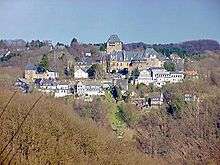

Locations of note in the city include:
Main sights
- Schloss Burg, the castle of the counts of Berg
- Müngsten Bridge, a railroad bridge connecting Solingen with the neighbour town of Remscheid. Standing at 107 m above the ground, it is the highest railroad bridge in Germany. It was constructed in 1897 and originally named the Kaiser-Wilhelm-Brücke after Wilhelm I
- Klosterkirche, former convent church (1690)
Museums
- Rhineland Industrial Museum Hendrichs Drop Forge, an Anchor Point of ERIH, The European Route of Industrial Heritage
- Deutsches Klingenmuseum (German Blade Museum), presenting swords and cutlery of all epochs
- Kunstmuseum Solingen (Museum of Art)
- Museum Plagiarius, the Plagiarius exhibition shows more than 350 product units – i.e., original products and their brazen plagiarisms – in direct comparison. The registered society conducts an annual competition that awards the anti-prize "Plagiarius" to those manufacturers and distributors that a jury of peers have found guilty of making or selling "the most flagrant" imitations.
- Laurel & Hardy Museum
Parks and gardens
- Botanischer Garten Solingen, a botanical garden
- Bärenloch
- Walder Stadtpark in Solingen-Wald
- Gustav-Coppel-Park
- Süd-Park
- Brückenpark beneath the Müngsten Bridge
Notable people
Born before 1900
- Johann Wilhelm Meigen (1764–1845), insect collector, specialist of Diptera
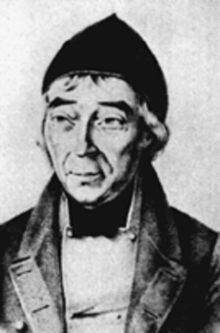

- J. C. C. Devaranne (1784–1813), helped to lead resistance against Napoleonic occupation in 1813
- Karl Mager (1810–1858), school educator and school politician
- Karl Adams (mathematician) (1811–1849), mathematician and teacher
- Albert Bierstadt (1830–1902), landscape painter
- Adolf Kamphausen, (1829–1909), biblical scholar
- Ernst Otto Beckmann (1853–1923), chemist
- Ludwig Woltmann (1871–1907), anthropologist, zoologist and neo-Kantian
- Artur Möller van den Bruck (1876–1925), writer
- Albert Müller (1891–1954), communist and politician
- Paul Voss (1894–1976), designer
- Paul Franken (1894–1944), socialist politician, victim of Stalinism
- Karl Allmenröder, (1896–1917), fighter pilot of the Luftstreitkräfte during World War I
- Carl Clauberg (1898–1957), Nazi SS gynecologist who carried out massive forced sterilizations and experiments on mainly Jewish concentration camp prisoners at Auschwitz concentration camp
Born after 1900
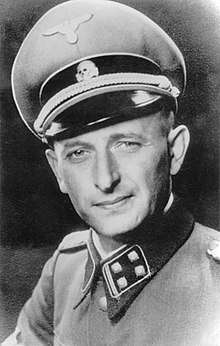
- Hermann Friedrich Graebe (1900–1986), manager and engineer, 'Righteous Among the Nations' by Israel
- Josef Dahmen (1903–1985), theater and film actor
- Adolf Eichmann (1906–1962), Nazi SS-Obersturmbannführer (Senior Assault Unit Leader) and major organiser of the Holocaust
- Georg Meistermann (1911–1990), painter of sacred and secular glass windows
- Jürgen Thorwald (1915–2006, pseudonym for: Heinz Bongartz), author of popular scientific representations
- Christel Rupke (1919–1998), swimmer
- Walter Scheel (1919–2016), politician (FDP), the 4th President of Germany (1974–1979)
- Klaus Lehnertz (born 1938), athlete
- Adolf Weil (1938–2011), motocross rider
- Christoph Wolff (born 1940), musicologist (Bach, researcher and director of the Bach Archive, at Harvard University
- Pina Bausch (1940–2009), dancer, choreographer and director of the dance theater of the same name in Wuppertal
- Michael Schade (born 1952), spokesman of the management of Bayer 04 Leverkusen Fußball GmbH
- Wolfgang Schwerk (born 1955), Ultramarathon runner
- Michael Lesch (born 1956), actor
- Andreas Schäfer (born 1957), director and author
- Ulay (Frank Uwe Laysiepen), artist, photographer and performer who performed with Marina Abramović
- Timotheus Höttges (born 1962), manager and board member of Deutsche Telekom
- Richard David Precht (born 1964), philosopher, writer and publicist
- Veronica Ferres (born 1965), actress
- Sebastian Thrun (born 1967), professor at Stanford University, founder of the online university Udacity
- Jens Weidmann (born 1968), President of Deutsche Bundesbank
- Mola Adebisi, (born 1973), TV-presenter
- Accept, Heavy Metal band formed in Solingen in the early 1970s
- Marco Matias (musician) (born 1975), German-Portuguese singer
- Fahriye Evcen (born 1986), actress
- Kevin Kampl (born 1990), Slovenian footballer
- Christoph Kramer (born 1991), soccer player and 2014 world champion
 Walter Scheel (1974)
Walter Scheel (1974).jpg) Richard David Precht (2009)
Richard David Precht (2009) Veronica Ferres (2012)
Veronica Ferres (2012) Christoph Kramer (2014)
Christoph Kramer (2014) Pina Bausch (2009)
Pina Bausch (2009)
The founders of Studebaker Brothers Manufacturing Company, which later became the automobile company Studebaker, trace their lineage to bladesmen from the region that migrated to America in 1736.[6][7]
Sports
American Football
The Solingen Paladins are an American football club from Solingen in North Rhine-Westphalia, which was founded in 2006. In the 2020 season, the Paladins will play their third season in GFL2 Nord, the second-highest division in Germany.
Baseball
The Solingen Alligators are a baseball and softball club from Solingen. The club was founded in 1991 and the first men's team was promoted to the first division of the Baseball Bundesliga for the 2003 season. It has played there in every season since, winning the league championship in 2006 and 2014. The club claims over 250 members.
Chess
The Schachgesellschaft Solingen e.V. 1868 is best known for its chess team, which plays in the Schachbundesliga (Chess Bundesliga), the top tier of the German chess league system, and is the most successful club in German chess history, having won a record 12 national titles (1969, 1971, 1972, 1973, 1974, 1975, 1980, 1980/81, 1986/87, 1987/88, 1996/97 and 2015/16), three national cups (1986, 2006 und 2009) and 2 European cups (1976 and 1990).
Handball
In handball, Solingen's most successful team is Bergischer HC, playing in the top-tier Handball-Bundesliga which they were promoted to for the second time in 2013, reaching 15th place in the 2013–14 campaign and therefore staying in the top flight for a second consecutive season. BHC originates from a 2006 cooperation between the SG Solingen and rivals LTV Wuppertal from the nearby city of the same name. The club advertises itself as a representative of the entire Bergisches Land region. The team plays its home games at both Solingen's Klingenhalle (2,600 seats) and Wuppertal's Uni-Halle (3,200 seats).
Reception
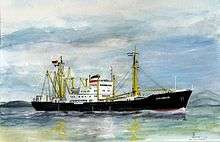
In May 1955, the city of Solingen took over the partnership of the German general cargo ship Solingen of the Hamburg-American Packet Transit Actien-Gesellschaft (Hapag).
International relations
Twin towns – sister cities
Solingen is twinned with:[8]







- sponsorship: citizens from the former district (Landkreis) Goldberg/Silesia, since 1955
References
- "Bevölkerung der Gemeinden Nordrhein-Westfalens am 31. Dezember 2018" (in German). Landesbetrieb Information und Technik NRW. Retrieved 10 July 2019.
- "Bevölkerung im Regierungsbezirk Detmold" (in German). Landesbetrieb Information und Technik NRW. Archived from the original on 25 March 2010. Retrieved 22 April 2010.
- http://solinger-bote.de/nachrichten/2014/11/05/solingen-gedenken-an-solinger-bombenopfer-vor-70-jahren/
- https://articles.latimes.com/1993-05-30/news/mn-41574_1_arson-attack
- Groneck, Christoph; Lohkemper, Paul (2007). Wuppertal Schwebebahn Album. Berlin: Robert Schwandl. pp. 58–61.
- DeWitt, Bill. "Family Origins and The Wagon Business". Studebaker 100. Archived from the original on 31 October 2016. Retrieved 17 May 2017.
- "History of the Studebaker Family and Company". Studebaker Family National Association. Archived from the original on 2 April 2016. Retrieved 17 May 2017.
- "Städtepartnerschaften und Patenschaft". solingen.de (in German). Solingen. Retrieved 2019-11-28.
External links
- Official website

- Travel guide from die-bergischen-drei.de (in German)


- . New International Encyclopedia. 1905.
